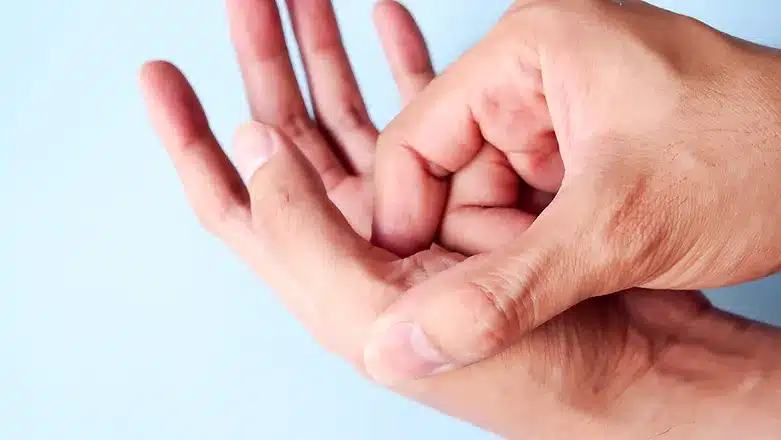Gamekeeper’s Thumb (UCL Tear)

GAMEKEEPER’S THUMB (UCL TEAR)
Gamekeeper’s Thumb, also known as Skier’s Thumb, results from acute or chronic injury of the ulnar collateral ligament (UCL). Bones are connected to one another by fibrous, strong connective fibres called ligaments. The primary ligament that helps stabilize the metacarpophalangeal (MCP) joint is the UCL, which is situated on the inside of the thumb. The UCL may be strained or torn (partially or completely), which weakens the thumb’s ability to grasp or pinch.
HAND & WRIST ANATOMY

DISEASE EXPLAINED

SYMPTOMS
Symptoms of Gamekeeper’s thumb or a UCL tear in the thumb may include:
• Bruising
• Joint pain
• Misaligned thumb
• Swelling
• Reduced range of motion
• Weakened grip
• Instability and pain with range of motion
CAUSES
Gamekeeper’s Thumb can be caused by acute injury or chronic overuse.
• Activities that require a tight grip, such as tennis, golf or skiing
• Fall on out stretched hand
• High-impact sports like rugby or football
• Motor vehicle accident
• Gaming
• Trauma
TREATMENT

TREATMENT OPTIONS
Nonsurgical treatments may be sufficient to reduce swelling and stabilize the joint as the ligament heals.
The most common conservative treatments include:
• RICE (Rest, ice, compression, elevation)
• Rest and immobilization
• Cast
• Splint
• Anti-inflammatory medications such as NSAID medications and topical agents
After the splint is removed hand therapy or strength exercise is recommended.
SURGICAL TREATMENTS
If there is a complete tear of the ligament, surgery will be required to repair the ligament. Delay in obtaining surgical intervention can increase complications and reduce the likelihood of full return of function. Surgical repair of the UCL can be performed on an outpatient basis using a minimally invasive approach. The ligament is anchored back to the bone using pins or sutures. The thumb is then placed in a cast or splint to protect the repair.
Eventually hand therapy is used to restore function and range of motion to the thumb.
CONTACTING DR. PERLMUTTER
Texting is preferred by Dr. Perlmutter for communication (717-836-6833). Please contact him ASAP, should you have any concerns whatsoever. Many patients fail to contact Dr. Perlmutter when they should have because they are "afraid of bothering him." This is a potentially dangerous attitude and Dr. Perlmutter will always welcome every opportunity to make his patients feel more comfortable. Please feel comfortable sending photographs to add perspective to your questions. Please turn on your flash, aim directly at the body part that you wish to show, and use an evenly colored, dark, and non-reflective background.
If you cannot text, you may call Dr. Perlmutter, however, you must use a confirmed caller ID unblocked telephone or he will not be able to return your call. If you need help turning off this feature you may:
1) Try pushing *82 prior to dialing, or
2) Use a different phone.
Your failure to do so will absolutely compromise your care and hurt your outcome!
If Dr. Perlmutter cannot be reached on his cell phone or by text, please contact the hospital operator to assist in reaching him or a member of his team. They can be reached at NASH: 252-962-8000. ECU Edgecombe: 252-641-7700.
IF YOU PERCEIVE AN EMERGENCY, PLEASE CALL 911 OR GO TO THE EMERGENCY ROOM ASAP.
DISCLAIMER
- All of the opinions expressed within the educational information delivered within the provided links are those of their authors and not necessarily those of either your treating doctor or CRO.
- This site is for educational purposes only!!
- Copyright Disclaimer under Section 107 of the copyright act 1976, allowance is made for fair use for purposes such as criticism, comment, news reporting, scholarship, and research. Fair use is a use permitted by copyright statutes that might otherwise be infringing. Non-profit, educational, or personal use tips the balance in favor of fair use.
